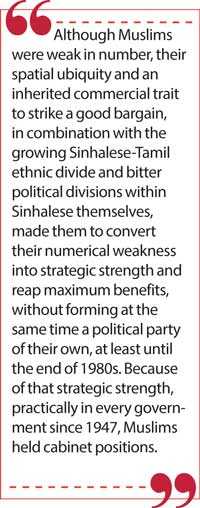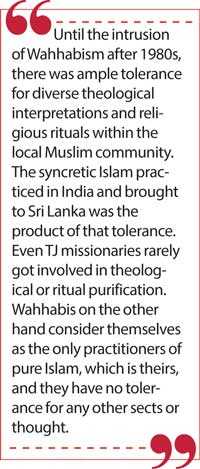Thursday Jan 08, 2026
Thursday Jan 08, 2026
Thursday, 14 May 2020 00:00 - - {{hitsCtrl.values.hits}}

A worrying development in post-2009 Sri Lanka is the rapidly deteriorating relations between Sinhalese and Muslims, and more accurately, between Buddhist Sinhalese and Muslims. The late historian Lorna  Dewaraja, in her pioneering study of The Muslims of Sri Lanka: One thousand years of Ethnic Harmony 900-1915, (The Lanka Islamic Foundation, Colombo, 1994) noted that the relationship between Sinhalese and Muslims was so peaceful, “it has passed unnoticed by the historian” (p.1). If something is an accepted norm who would waste time talking or writing about it? It was a millennium of an unparalleled golden era, when Islam and Buddhism, and Muslims and Sinhalese commingled and coexisted as one integrated community, and as happened nowhere else in Asia. Even after the first Sinhalese-Muslim riot in 1915 – an aberration brought about by the evils of a laissez-faire economy – the closeness between these two communities grew even stronger, in spite of certain sporadic and localised disturbances, which, in most cases were settled quickly by the intervention of community leaders, and on a few occasions where there was a threat of escalation prompt action by governments brought peace and quiet.
Dewaraja, in her pioneering study of The Muslims of Sri Lanka: One thousand years of Ethnic Harmony 900-1915, (The Lanka Islamic Foundation, Colombo, 1994) noted that the relationship between Sinhalese and Muslims was so peaceful, “it has passed unnoticed by the historian” (p.1). If something is an accepted norm who would waste time talking or writing about it? It was a millennium of an unparalleled golden era, when Islam and Buddhism, and Muslims and Sinhalese commingled and coexisted as one integrated community, and as happened nowhere else in Asia. Even after the first Sinhalese-Muslim riot in 1915 – an aberration brought about by the evils of a laissez-faire economy – the closeness between these two communities grew even stronger, in spite of certain sporadic and localised disturbances, which, in most cases were settled quickly by the intervention of community leaders, and on a few occasions where there was a threat of escalation prompt action by governments brought peace and quiet.
This cordiality and tolerance appears to have changed dramatically after 2009 and with the defeat of Tamil separatism. This does not mean that every Sinhalese has become overnight a rabid Islamophobe bent on wiping out the Muslim community. Nor does it mean that every Buddhist and its clergy wants Islam be obliterated from the face of Sri Lanka. In fact, if there were two ‘religions’ (Buddhism and Islam are not religions in the Western sense but ways of life) in history that coexisted with mutual respect and tolerance all along the Silk Road, it was Buddhism and Islam1. Sinhalese are one of if not the friendliest people to live with and Buddhism is a fortress for compassion and tolerance. How then does one explain the recent deterioration of Sinhalese-Muslim or Buddhist-Muslim relations and particularly after 2009? To answer this question, one has to take a few steps back in history and look at the developments - political, economic and sociocultural - that took place in post-independent Sri Lanka.
Sinhalese-Muslim political relations
With political independence, which was more of a gift from Britain than of an achievement through a collective liberation struggle by the different ethnic and social segments of plural Sri Lanka, which could be argued as the primary reason why the country has still not developed a collective nationhood, the country inherited a democratic constitution with the Westminster model of representative government. Although political parties were formed and elections were contested, ethnicity, religion and caste played a crucial role in determining the outcome of those contests. Without much exaggeration one could safely conclude that it was the Sinhalese-Tamil ethnic divide that largely influenced not only election victories but also important government policies and programs. How did this politics affect Sinhalese-Muslim  relations?
relations?
In the demographic profile of the island, Muslims (Moors and Malays) form the second minority with 9.5% of the population in 2011 census, while Sinhalese accounted for 74% and Tamils 15.5% (Indian and Sri Lankan varieties). Religious wise, Buddhists counted 70%, Hindus 12.5% and Muslims 9.7%. Although Muslims were weak in number, their spatial ubiquity and an inherited commercial trait to strike a good bargain, in combination with the growing Sinhalese-Tamil ethnic divide and bitter political divisions within Sinhalese themselves, made them to convert their numerical weakness into strategic strength and reap maximum benefits, without forming at the same time a political party of their own, at least until the end of 1980s. Because of that strategic strength, practically in every government since 1947, Muslims held cabinet positions.
This political relationship between Sinhalese-dominated Governments and Muslims, not only proved beneficial to Muslims but also to the Government and country at large. For example, in the context of deepening bitterness between Sinhalese and Tamils that was driving them towards fighting a war, generous accommodation of Muslim demands by successive Governments with prestigious cabinet positions offered to Muslim parliamentarians, (for example, Dr. Badiuddin Mahmud as Minister of Education in the Sirimavo Bandaranaike Government and A. C. S. Hameed as Foreign Minister in Jayawardene Government) helped to advertise and sell an image of ethnic and religious tolerance to the outside world, which brought in attractive economic benefits especially from Arab countries. In a sense, the Non-Aligned Summit held in Colombo in 1976 was a singular achievement of Sinhalese-Muslim friendship.
However, this friendship was not free of criticism from certain sections of the Sinhalese community. Sometimes ministerial grudges and factional rivalry within the cabinet, like that of a running battle among Felix Dias, Ilangaratne and Badiuddin in Sirimavo cabinet, were allowed to spill over outside the Parliament and sometimes erupted into sporadic Sinhalese-Muslim clashes. A number of such incidents, in Kandy, Gampola and Puttalam in 1970s could be attributed to this inter-ministerial animosity. Also, on a broader level there was a growing dissatisfaction amongst leading Sinhalese personalities and civil groups of the disproportionate political influence of Muslim leaders, who were viewed as king-makers. J.R. Jayawardene (JR) was one politician who was determined to put an end to this. In a fit of anger, he once asked all Muslim MPs and Muslim ministers in his Government to quit, when they protested against his decision to allow Israel to open a consulate in Colombo. Later, it was also to cripple the king-making role of Muslims that he brought in the system of proportional representation. That measure obviously backfired. Quite unintentionally, he became the midwife not for a revolution, as the leftists were lecturing for a long time, but for the birth in 1988 of a Muslim ethnic party, Sri Lanka Muslim Congress (SLMC), which became even more influential in the Chandrika Bandaranaike Kumaratunga (CBK) presidency.
For instance, the mega-ministry of Shipping, Ports and Rehabilitation held by SLMC’s founder-leader M.H.M. Ashraff, virtually became an employment agency for young SLMC supporters from the Eastern Province, just as the Ministry of Education was for educated Muslims under Badiuddin in 1970s. Ashraf was also accused by Buddhists that he allowed Muslims to encroach into lands which belonged to Buddhist temples in Dighavapiya in the Eastern Province. Adding fuel to fire, Ashraf’s much publicised verbal encounter with Ven. Soma, a prominent Buddhist priest, in which the latter was reported to have emerged second-best, was a strategic blunder by the exuberant leader, which only helped to aggravate Buddhists’ anti-Muslim feelings. After Ashraff’s tragic death, the SLMC continued to hold prominent positions under CBK’s successor, Mahinda Rajapaksa (MR), and continued to damage Sinhalese-Muslim relations.
Sinhalese and Muslim economic relations
If there is one profession that could be justifiably described as Islamic, it is trade. Accordingly, Muslims arrived in Sri Lanka as traders and remained so until late into 20th century, earning in due course the sobriquet, “business community”. The absence of a trading class amongst Sinhalese and perhaps a desire to cultivate friendship with the then-super power Abbasid Caliphate, prompted ancient Buddhist monarchs to welcome the new arrivals and allow them remain permanently, which heralded the golden era referred to at the beginning.
In a critical analysis of “Contemporary Buddhist-Muslim Relations in Sri Lanka”, my former colleague at Peradeniya, Professor Gerald. H. Peiris observes, that “in the daily lives of a large majority of people living in most parts of the island their inter-ethnic relations are seldom interaction among equals.”2 In a caste, ethnic, and religious-conscious society there will always be certain rigidities that hinder inter-communal interaction on equal terms. However, the interaction between the Sinhalese and Muslims at the mass level was chiefly market oriented and pecuniary. When a seller and a buyer successfully negotiate and complete a transaction, they both normally go equally satisfied. However, as a class of professional middlemen, Muslims bought from and sold to a predominantly Sinhalese clientele. In that transaction, as middlemen do everywhere and at all times, Muslims enjoyed multiple opportunities for profiting. Although this relationship remained the principal mode of interaction, especially during colonial times, it continued to persist even after independence.
However, trade and commerce in the retail sector was not the monopoly of Muslims. A class of Sinhalese entrepreneurs and businessmen emerged during the British era and began to compete with Muslims. This competition then became intense after independence and Sinhalese-Muslim economic relations became strained. Free market does not guarantee success to everyone who enters it. This is why monopoly of some sort becomes an attractive option to any trader with sufficient means. At least in two sectors, textiles and gems, Muslim businessmen enjoyed a near monopoly in decades following independence. Almost in every town and city in the Sinhalese districts textile shops owned by Muslims, who were not necessarily belonged to the locality, became a permanent feature. For instance, traders from Kattankudy in the Eastern Province almost dominated the textile business in towns as far as  Lunugala, Passara, Badulla, Bandarawela, and Welimada in the Uva Province. In Sinhalese villages too, Muslim peddlers of cloth and trinkets were omnipresent during weekly markets and festival fairs. Likewise, in the gem trade, Muslims of Beruwela virtually enjoyed a monopoly. When ethnic or religious minorities become economically successful, it tends to provoke resentment form the majority. This happened against the Chinese in Malaysia, and Indians in Kenya, Burma and Fiji. A similar trend started developing in Sri Lanka also, and the voice of Sinhalese resentment against Muslim businessmen reached the ears of local priests in Buddhist temples. It is this combined opposition from Sinhalese business interests and Buddhist clergy against Muslim businesses that became the common thread weaving several Sinhalese-Muslim riots after 2009.
Lunugala, Passara, Badulla, Bandarawela, and Welimada in the Uva Province. In Sinhalese villages too, Muslim peddlers of cloth and trinkets were omnipresent during weekly markets and festival fairs. Likewise, in the gem trade, Muslims of Beruwela virtually enjoyed a monopoly. When ethnic or religious minorities become economically successful, it tends to provoke resentment form the majority. This happened against the Chinese in Malaysia, and Indians in Kenya, Burma and Fiji. A similar trend started developing in Sri Lanka also, and the voice of Sinhalese resentment against Muslim businessmen reached the ears of local priests in Buddhist temples. It is this combined opposition from Sinhalese business interests and Buddhist clergy against Muslim businesses that became the common thread weaving several Sinhalese-Muslim riots after 2009.
Muslim businesses and Muslim economy received a rude shock when the leftist coalition led by Sirimavo Bandaranaike came to power in 1970 and started the socialist economic experiment. In that, restriction of market enterprises, nationalisation of industries, control over external trade and land reforms hit the Muslims harder. Realising the losses accruing to his community, Education Minister Badiuddin Mahmud invited a group of Muslim leaders to a Tea Party at his Colombo residence in 1972 and warned them not to swim against the socialist tide, but to change direction and look for other avenues to survive. He himself used education as one escape valve, and before the end of the socialist regime in 1977 he turned the so called “business community” more or less into a teachers’ community. It was his fearless use of that ministry as virtual employment agency for educated Muslims that created the inter-ministerial rivalry and Sinhalese-Muslim clashes referred to earlier.
With the end of the socialist experiment, Muslims resumed their business pursuits, perhaps with vengeance, under JR’s open economy. His economic model was capitalism in all its nakedness. A number of Muslims who were employed in the education sector hitherto resigned their positions and either became businesses entrepreneurs locally, or migrated to the Middle East in search of lucrative jobs. Those emigrants, on return after their sojourn, invested their savings in businesses. The world of private business in the country was becoming an arena of intense competition with entrepreneurs and investors from all ethnic groups. In this competition a few Muslim businesses such as the two leading retail fashion chains, No Limit and Fashion Bug, performed exceptionally well, which aggravated the already growing commercial jealousy amongst a group of Sinhalese businessmen.
Socio-cultural issues
Socio-culturally there had been absolutely no impediments, and there is no evidence to the contrary, to disturb the peaceful interaction and coexistence between Sinhalese and Muslims for over a millennium. The influence of Sufism that was injected predominantly from the Indian subcontinent, and the syncretic nature of a number of Islamic practices adopted by local Muslims found a great degree of acceptance within the ethos of Buddhism. As mentioned at the beginning, Islam and Buddhism interacted and cross pollinated culturally throughout the historic Silk Road. After independence however, two different waves of Islamic influence, one coming from the subcontinent since late 1950s in the form of Tabligh Jamaat (TJ), and the other from Arab Middle East from 1980s started creating fissures in Sinhalese-Muslim socio-cultural cohesion. Of the two, it was the second that proved more destabilising.
TJ is an Islamic missionary movement that wants to make Muslims better Muslims in terms of religious observance. It is exceptionally peaceful in approach, which is its strength, and entirely otherworldly in objective, which is its weakness. Its mission has spread universally, and it is very popular particularly where Muslims live as minorities. Because of its tremendous success in Sri Lanka, by 1980s the country had become an exemplar for TJ activities. TJ rarely got involved in conversion of non-Muslims although tens of thousands of them attracted by the simplicity, selflessness, brotherhood and spirituality of TJ activists had accepted Islam as their new faith.
One outstanding achievement of TJ mission in Sri Lanka is the preponderance of worshippers crowding inside mosques, which necessitated the construction of more and spacious mosques to accommodate the size, a development that started irking Sinhalese nationalists. By 1987, the country had 1,600 mosques and the number was increasing. JR’s open economy allowed funds to flow in from the Gulf States and private Arab donors that went directly into building centres of worship and Islamic education.
Unlike the TJ inspired Islamic wave from India, the second wave was the product of an Islamic awakening that originated in the Middle East in late 1970s, with Khomenian impulse. It was the Iranian Revolution led by Ayatollah Khomeini that toppled the Western backed Shah and established an Islamic government in Iran that gave rise to the slogan ‘Islam the Answer’, which went viral amongst the Muslim youth. The anti-American propaganda exported by the Iranian regime frightened the super power, which started looking for an antidote for Khomeinism, and found it in the ultra-conservative doctrine of Wahhabism rooted in Saudi-Arabia, America’s “Eternal Friend”. US gave free license to the Saudis to spread their doctrine the world over, including the US. JR’s open economy coincided with the clash of two Islamic orthodoxies, Shiite Khomeinism and Sunni Wahhabism.
In an open economy, it is not only products and productive factors that move across borders but also ideas, ideologies and even behavioural modes. Thus, through the gates of JR’s open economy or Dharmista Samajaya, as described by that great Sinhala Buddhist playwright Ediriweera Sarachchandra3, Wahhabism entered Sri Lanka not only to disturb the prevailing intra-faith harmony within the Muslim community, but also to damage inter-ethnic harmony between Sinhalese and Muslims.
Until the intrusion of Wahhabism after 1980s, there was ample tolerance for diverse theological interpretations and religious rituals within the local Muslim community. The syncretic Islam practiced in India and brought to Sri Lanka was the product of that tolerance. Even TJ missionaries rarely got involved in theological or ritual purification. Wahhabis on the other hand consider themselves as the only practitioners of pure Islam, which is theirs, and they have no tolerance for any other sects or thought. They hate the Shi’a and they have no tolerance for Sufism. Already in the 1990s, Kattankudy in the Eastern Province, the birth place of the jihadist Zahran and his National Tawheed Jamaat, witnessed the first outbreak of intra-faith violence between Wahhabis and followers of two other Sufi movements4, a development that was to have serious ramifications later.
Wahhabism’s contribution to inter-ethnic disharmony in general and deteriorating Sinhalese-Muslim relations in particular came out of certain behavioural changes that crept into the Muslim community, which quite unintentionally set a trend towards the community’s self-alienation. From 1980s onwards one could see a distinct difference in the sartorial accoutrement of Muslim men and women, which enhanced that alienation. While many of the men adopted the Arab thobe and gave up the traditional sarong and shirt worn by most ordinary Sri Lankans, large number of women started wearing the black abaya, niqab and burqa and gave up the traditional sari and salwar. With these changes gender segregation, an important feature of Wahhabism came to be adhered more strictly. One only has to walk into any university in the country to see how Muslim female undergraduates are covered in black and how segregated they are in the lecture and tutorial rooms, a phenomenon never existed before 1980s. The fact that this dress is unsuitable to the climate and culture of the country, the two basic determinants of dress in any society, was ignored in the name of religious identity.
Self-alienation also manifested in the way Muslim townships like Kattankudy were changing in their appearance. While Arabian date palms were planted to beautify streets, names of business sign boards and public buildings started appearing in Arabic script.
It was in this ambience of ultra-conservative orthodoxy that the issue of halal came up. This had nothing to do with Wahhabism directly, but everything to do with business opportunities arising from closer contact with Arab countries. Muslims had been eating halal food from the day they arrived in this country without any problem. No Sinhalese or Tamil, neither a Buddhist, nor a Christian and not even a vegetarian Hindu ever protested against this Muslim practice, although Buddhists never liked slaughtering of animals and Hindus the cows in particular. Why did it become an issue after 1980s? Once again, one can trace the reason to JR’s open economy. Halal food is a multibillion dollar business in the global market. Petrodollar Muslim nations and millions of Muslims living the West demand not only halal meat but also edible items free of alcohol content and other sharia proscribed ingredients. This had led to a plethora of government-approved halal certifying agencies in exporting countries, and those agencies charged fee for their services, which increased suppliers’ cost and was loaded on to the price paid by consumers. In a number of instances, which I am personally aware of, the agents were more concerned about the fee they received than services they offered. In Australia, there were instances when a certifier issued certificates by faxing them to the exporting company without even stepping into the abattoir. There is also differences of opinion about what is halal and what is not.
In Sri Lanka, the All Ceylon Jamiyythul Ulama (ACJU) took upon itself the role of certifying in return for a fee. Since it acted as a monopolist, the fees it charged could not have been competitively arrived but arbitrarily fixed, and therefore understandably high. Whether ACJU was appointed by the Government I am not aware. However, not all the halal-certified products were exported and some of them entered domestic market and were bought by non-Muslims also. Obviously the price of that product would be higher than the non-halal variety. No wonder, Muslims were accused of cornering the market through halal certification, and the halal issue added to an already troubled Sinhalese-Muslim relationship. The entire issue was mishandled from the beginning by the Government and ACJU.
Before concluding this part, two more aspects of TJ-Wahhabi Islamisation needs be highlighted. As mentioned earlier, the influence of TJ among Sri Lankan Muslims was quite widespread and deep when Wahhabism entered in 1980s. In fact, Wahhabism built its own influence on foundations laid by TJ. Internationally too and within the world of Sunni Islam, these two movements revived and strengthened the old Islamic identity of ummah or universal community introduced by the Prophet of Islam, which in course of time and with development of nationalism clashed with the identity of watan or nation. What the ummah identity in Sri Lanka did was for Muslims to self-alienate from the mainstream society in the name of preserving their religious identity. (This was not unique to Sri Lanka. There was at this time one or two leading activists, who went around Western countries like Australia and advocated the view that Muslim minorities should isolate themselves in a separate enclave and live according to the commandments of the sharia). In short, belief and belonging began to clash under the watchful eyes of community leaders.
The other aspect of this disturbing development was Islamisation of Muslim politics. SLMC under Ashraf was gradually turning into an Islamist party. Its flag, slogans, conditions of membership and public campaigns, all had an overbearing Islamist tone. I have dealt with this aspect in great detail in my chapter to a forthcoming book on Radicalisation and Counter-Radicalisation, edited by Professor Samina Yasmeen from the University of Western Australia.
In conclusion, the disproportionate political influence of Muslims, their successful economic enterprises, and publicly displayed religiosity, all created consternation among certain influential quarters of Sinhalese society. But, it did not come to the open and become phobic as it did after 2009, because the immediate threat and the main enemy at that time were the Tamils and their armed struggle for Tamil Eelam. From the point of view of the Sinhalese that struggle posed an existential crisis. The annihilation of LTTE in 2009 changed the situation dramatically.
Notes:
1John Silverskog, Buddhism and Islam on the Silk Road, University of Pennsylvania Press, 2013.
2https://thuppahi.wordpress.com/2017/09/14/a-study-of-contemporary-buddhist-muslim-relations-in-sri-lanka/
3Ediriweera Sarachchandra, Dharmista Samajaya, Colombo: Elko Industries, 1982.
4Ameer Ali, “Kattankudy in Eastern Sri Lanka: A Mullah-Merchant Urban Complex Caught between Islamist Factionalism and Ethno-Nationalisms”, Journal of Muslim Minority Affairs, vol. 29, no. 2, 2009, pp. 183-194.
(The writer is attached to the School of Business and Governance, Murdoch University, Western Australia.)